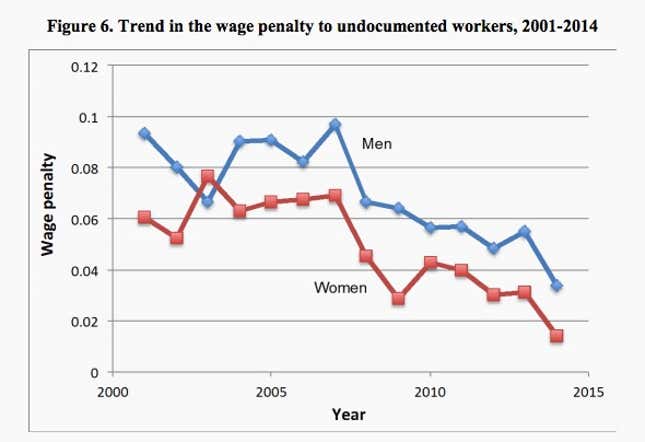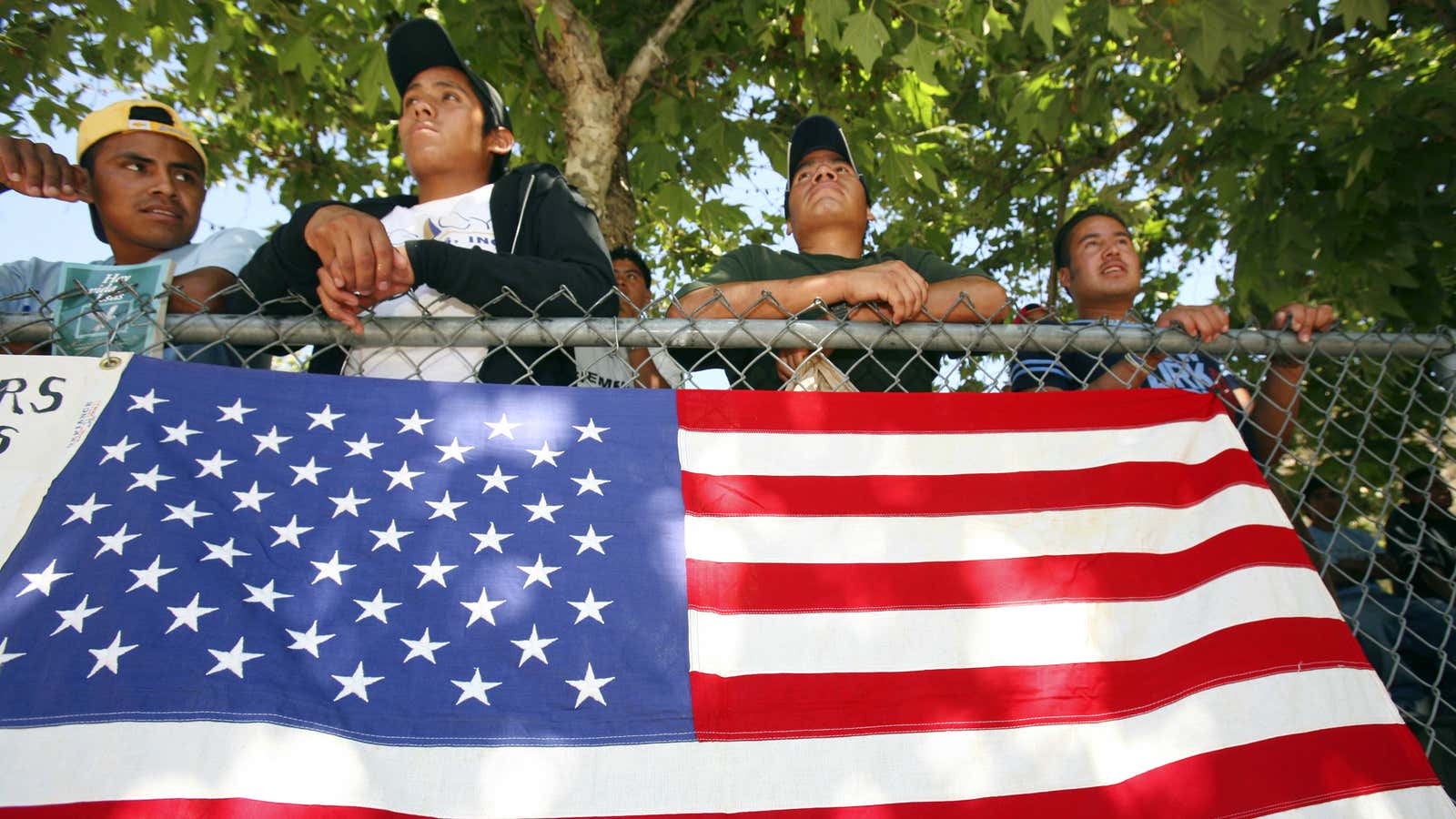George Borjas, a veteran labor economist at Harvard, just made a strange discovery. Since the early 2000s, unauthorized immigrants have gotten paid around 9% less, on average, than legal workers with the same skills and backgrounds, he found. Then all of a sudden in 2008—just as the American economy tipped into the abyss of the Great Recession—the average hourly wages of unauthorized immigrants started to climb. And as their pay rose, that “wage penalty” started shrinking, falling under 6% in 2010. By 2014, unauthorized immigrants, on average, earned only 3.4% less than their legal peers.
Borjas details his findings in a National Bureau for Economic Affairs working paper (paywall). The findings suggest unauthorized immigrants are ”not doing as badly in today’s labor market because of their status as is typically assumed,” says Borjas.
But his discovery also leaves us with a mystery that neither he nor his fellow immigration economists can easily solve. That is, what caused wages to rise, squeezing that long-persistent wage gap between legal and illegal immigrants almost shut? To chip away at this question, it helps to understand why unauthorized workers tend to get paid less in the first place.
Why is the gap shrinking?
Only in 1986 did US lawmakers ban employers from knowingly hiring workers who were in the US illegally. That made unauthorized immigrants, in theory, riskier to hire—introducing extra costs that employers would share with their unauthorized hires by discounting their wages.
And because an immigrant’s undocumented status makes it harder to access legal protections, bosses could get away with paying illegal hires less than they do legal workers with the exact same skills.
Since their status also bars unauthorized immigrants from taking jobs that require background checks or licensing—which means many medium- or higher-skilled jobs—well-educated immigrants wind up working low-skill jobs. In Borjas’ analysis, which adjusts for education level, these immigrants make vastly less money than what legal workers with the same skills and educational levels would earn. (By the way, for ease of comparison, we’re talking about the wage trends of male immigrants here. Those for undocumented women are generally similar, though often less pronounced.)

Theory one: Obama’s election.
While there’s no obvious explanation for what sparked the abrupt shrinking of the wage gap, 2008 is, for many reasons, pivotal: It’s the year Barack Obama won the presidency. Of course, Obama deported record numbers of immigrants, earning himself the monicker “deporter-in-chief.”
But Borjas says he is skeptical of the Obama administration’s numbers. More significantly, Obama also made sweeping changes that helped unauthorized immigrants. The most concrete action by his administration, the Deferred Action for Childhood Arrivals (DACA) policy, grants unauthorized immigrants who came to the US as children indefinite protection from deportation and eligibility to work legally. During his administration, dozens of cities took steps to make unauthorized immigrants feel safer in their communities, shielding them from random deportation. These are examples of what Borjas calls “a favorable shift in the legal environment” toward unauthorized immigrants during the Obama administration.
Regardless of why unauthorized immigrants had been getting paid less, “if enforcement has become more lax over time, it means that these penalties no longer apply,” says Michael Ben-Gad, economics professor at City University of London. “Immigrants can venture into occupations that were once unavailable, and are perhaps more willing to insist on equal pay.”
Indeed, Borjas’ research turned up an intriguing pattern that suggests the policy and legal environment could play a key role. Contrary to the “sanctuary cities” springing up in some states, a handful of other states—Arizona, Alabama, Mississippi, and South Carolina—have instituted aggressive policies requiring businesses to check employment eligibility of their prospective hires, starting in 2008. In these states, Borjas found, the wage penalty widened by a whopping 40%.
Had the rest of the US become so legally permissive that unauthorized workers began competing almost directly with their legal counterparts?
“This is certainly one conjecture—that the recent decade has seen a more welcoming approach to illegal immigration in general,” Borjas says. But since there are no tests of that hypothesis at the national level, “this is only a conjecture.”
Though this narrative makes intuitive sense, the timing doesn’t necessarily line up, however. The most momentous reform, DACA, only began in June 2012, notes labor economist Jennifer Hunt of Rutgers University—meaning the wage gap’s narrowing predates DACA by a good four years.
Theory two: Less competition from other unauthorized workers.
Of course, the other conspicuous event that hit around 2008 was the housing market crash and the Great Recession that followed it. The implosion of the US job market and housing construction demand sent many returning to their native countries. (As of 2008, about 17% of construction workers were unauthorized according to Pew Research Center).
Since unauthorized immigrants compete most directly with each other, that mass departure could have boosted their earnings. Yet, even as the US’s unauthorized immigrant population stabilized, the wage gap kept on falling. “It could have been the recession initially and now it’s a completely new and different thing,” says Hunt.
Another kink she sees in this narrative is that the number of Mexicans leaving the US had already picked up markedly in the first half of the 2000s, well before the 2007 housing market collapse. (This was thanks in part to stepped-up deportations under president George W. Bush, but mainly to Mexico’s improving economy and the aging of its population opening up jobs.) At the same time, inflows from Mexico—though not necessarily from other countries—slowed.
Theory three: America’s new cast of unauthorized immigrants.
This all highlights what Borjas calls a ”stumbling block” to understanding what exactly is shrinking the wage penalty: the ever-changing composition of undocumented workers.
And it clearly has changed a lot. Overall, the US population of unauthorized immigrants peaked in 2007, at 12.2 million, according to Pew Research Center. Whether voluntary or because of deportation, between 2007 and 2014, a net 1.1 million people had left.
But again, this says nothing about who those immigrants are—and how they differ from those in the US just a few years earlier. In addition to stepped-up enforcement and changes in the US economy, conditions in common countries of origin could be important factors too.
For instance, unlike a good chunk of the previous decades’ unauthorized immigrants, the recent influx is from Central America, not Mexico, involves women and children, not working-age single men, and is fleeing humanitarian strife, not looking for better job prospects. On top of all this, immigration statuses are always in flux, as some unauthorized immigrants succeed in obtaining green cards. The balance of who’s gone, who’s arrived, who’s managed to stay, and who’s competing against whom has reshuffled in unknowable, but possibly profound, ways. And those could be factors influencing the wage gap’s closing.
In particular, the exodus of Mexicans returning home may have swept clear worker competition for lower-skill, entry-level jobs. And as Rutgers’ Hunt already pointed out, since fewer of these unauthorized workers stepped in to replace them, wages would have climbed as a result. However, like the changing composition of immigrants themselves, the base of skills and education among the remaining unauthorized workforce would likely have changed as well, says Pia Orrenius, an economist specializing in immigration at the Dallas Federal Reserve—and that could have helped squeeze the wage gap.
Theory four: Better English.
For instance, Orrenius’ research finds that education and English proficiency are key predictors of wages and employment. Language barriers in particular shunt unauthorized immigrants to the jobs where talking doesn’t matter much—for instance, agricultural work, construction, domestic work. Between 2000 and 2013, educational levels and facility with English improved among both existing Mexican immigrant populations and recent Mexican immigrants (including both legal and illegal immigrants), according to her research. The ability to work in whole new swaths of consumer-facing services would in theory up the bargaining power of unauthorized immigrants with solid English.

However, in his paper, Borjas takes a crack at testing for many of these possibilities. For instance, he finds that the wage penalty shrank among unauthorized immigrants who arrived in the US in the last year, as well as those who have been living there for 10 and 20 years. The wage penalties between those groups are different, but the fact that they both started shrinking at the same time and by roughly the same magnitude suggests a shared cause.
The same is true for age, state of residence, country of origin, and other characteristics that differ among the US’s 8 million unauthorized workers.
“Borjas considers several possibilities and seems to be able to reject them all,” says Rutgers’ Hunt. “It’s an interesting puzzle we’re left with.”
The missing piece?
It’s also possible the shaking up of America’s unauthorized population has made it harder for the US government and scholars to track them. Since no one’s going to proclaim their illegal status to government officials, counting unauthorized immigrants is not straightforward. To pick them out from US government population data, Borjas and other leading scholars use proxies to flag immigrants who are likely legal—for example, whether the person receives Social Security, is a veteran, works for the government or in a field the requires licensing, has a legal immigrant spouse. The remaining immigrants are considered unauthorized. But some research also suggests that US government data may be undercounting a bigger share of unauthorized immigrants than is realized. And as the stock of unauthorized immigrants changes over time, methodologies that worked in the past might be less effective at finding them.
Assuming Borjas is still right about the wage gap, though, he concludes that “regularizing” unauthorized people may improve their average earnings only marginally. Between 1989 and 1992, during the last period in which the US government gave nearly 3 million unauthorized immigrants legal status, wages rose only around 6%. Borjas notes that if his analysis is right, today’s unauthorized immigrants will benefit even less.
But, says Hunt, the Rutgers economist, “Undocumented workers are not wanting to be documented solely to earn more.”
The Dallas Fed’s Orrenius adds there’s also “quality of life and access to other things that are really important—like the ability to get a bank loan, a driver’s license, to go home to Mexico when your mother dies,” she says. “And now, in some cases, not to be in fear of the police—to know that you can call the police in an emergency and not have to worry, ‘Gee, I might be arrested.'”
